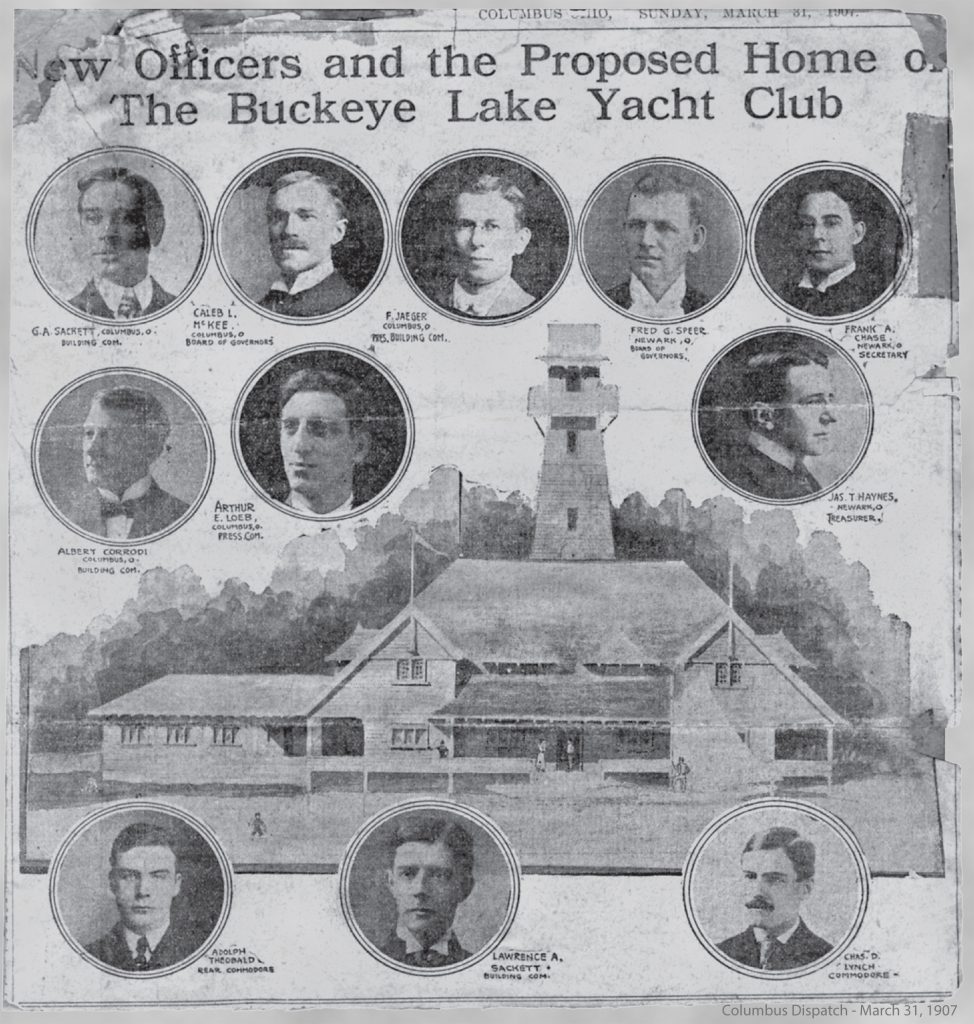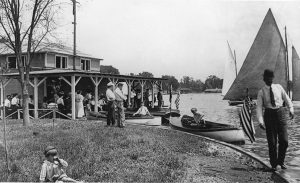Commodore Steve Harris – December, 2017
The need to raise money for improvements at BLYC is nothing new. It has been with us since our founding.
Commodore Foster wrote on this very topic in 1990 in his “The Way We Were” history column in the Log. Much of the information that follows comes, with appreciation, from his article.
When BLYC was founded in 1906, it had no home. The first meeting at the lake was held on Orchard Island at a private home and that year’s July 4th and Labor Day regattas were held at the Lake Tourist Hotel at Shell Beach. Meetings and the annual “Tar Socials” were held at various restaurants and meeting halls in Columbus and Newark.
The Club itself lacking the assets to build, but in need of, a clubhouse, a group of members formed the Buckeye Lake Building Company in 1907. A separate, for profit corporation, the Building Company sold shares both to members, and the Club itself. They secured a lease on a spot of “sometimes land, surrounded by always shallow water, and, in spring season, frequently flooded completely” known then as “Sunken Island,” borrowed $200 from the Club for start-up expenses, and authorized the sale of 1000 shares at $5.00 each to finance their efforts. They commissioned an architecht to draw up plans for a grand clubhouse which were published in the Columbus Dispatch on March 31, 1907 – a copy of which hangs in the Cupola Lounge today. To quote Armstrong:
“The clubhouse was depicted as a rustic, slab-sided, casement windowed, two-storied structure with steeply-pitched, hipped, gabled and dormered roofs of wooden shingels. Long main roof slopes extorted downward over three separate porches facing westward, southward and eastward, the last of which continued beyond the rear of the building to main shore as the covered footbridge. High above the lofty rooftop stood a square tower, tapering upward, crowned by a bracketed, balustered, lookout balcony, facing all sides…”

Columbus Dispatch, March 31, 1907
This design was far more costly than the Building Company could afford to finance so a less extravagant design was settled upon – and nothing like the design of our current Clubhouse.

Our first Clubhouse, built in 1907, was little more than a set of small boathouses (located where the current covered docks are today). The south end of which included a second story “clubroom.” A porch was later added in 1910. Built at a cost of $1,811 (approx. $45,000 today), it was simple and spartan, but it was affordable and filled the immediate need. The cost of construction was more than the available assets and the Building Company was forced to secure a mortgage on the Clubhouse to continue. Needed improvements were made to make the island attractive and usable and for upkeep and operations of the building. By the end of 1908, the Building Company had incurred debt in excess of the value of the building – on the newly renamed “Watkins Island,” which was still leased from the State of Ohio at that time.
While BLYC leased the Clubhouse from the Building Company for $350/year, this barely covered the operational expenses and definitely didn’t add any assets towards building the “real Clubhouse” that was desired. The first effort of the Club to raise the necessary capital was undertaken later in 1908. The Club increased the cost of becoming a member by $10 – requiring the purchase of two shares in the Building Company in addition to the $2 initiation fee and $4 annual dues already in place.
As the years moved forward, talk of a “real Clubhouse” increased and, in 1910, Harry Holbrook, a noted Columbus architecht, was admitted to membership and was expected to make it happen. Holbrook (Commodore 1914-15) designed, among other central Ohio landmarks, the Midland Theater in Newark and the Ohio State Fairgrounds Colisseum. The Club’s Ways & Means Committee made recommendations for raising money, amid fears of losing members due to increased costs. Wanting to maintain control of the Building Company and the new Clubhouse, BLYC sought to purchase as many of the available shares it could. Dues were raised to $4 and a life membership was offered at $75 to assist in this effort. By 1913, BLYC owned 663 of the 775 shares that had been sold. The new, current Clubhouse was completed in February of 1913 at a cost of around $5,000 (approx. $125,000 today). Through the years, and thanks in great part to the generosity of Commodore Edgar T. Wolfe (1934), the club was able to secure all of the shares and the Building Company was dissolved in 1938. BLYC now owned its home.
During these years, and beyond BLYC would face a number of needs that required additional capital funds to be raised as well.
The 1928 tornado caused over $5,000 worth of damage (approx. $75,000 today) but the Club only had $1,000 available for repairs. Members were assessed $10 each (approx. one year’s dues) and all but two came through to help their Club. Some members gave even more – as much as $300 (approx. $4,000 today.)
During the winter of 1932-33, the Club held the first of several “Stag Parties” – which undoubtedly included gambling. Except for a few unhappy losers, these events were hugely successful and helped to raise additional monies for the Club. These parties would continue for another ten years until World War II interrupted activity at the Club.
Over the years, many necessary repairs, changes, and improvements have occurred at BLYC – enclosing the current dining room in 1925 and the Commodores Lounge in 1973, the addition of electric service, HVAC, and other utlities to the building, expanded seawalls and docking areas on Watkins Island in the 60’s, removal of the old boathouses and construction of the current covered docks in the late 70’s, the purchase of Eastport and addition of the swimming pool in the 80’s, the kitchen and bar remodeling in the 90’s, additional property acquisitions and structural repairs and upgrades over the years, and construction of the Eastport docks in the early 2000’s to name but a few. In each case, whether it be thorugh traditional financing methods, assessments, the selling of bonds, the offering of life memberships, generous benefactors & donors, or other creative means, BLYC has managed to come together for the good of all members and our fine Club to not only continue, but also continue to grow and progress into the future. As we face new challenges and needs today, we will undoubtedly do likewise again.
